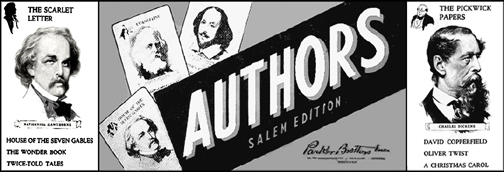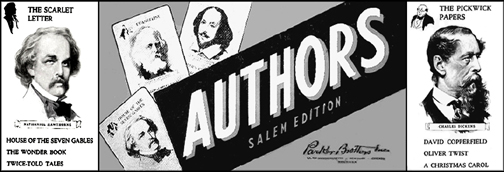Today’s column is dedicated to my uncle, Ray Reaves, who passed away recently at the age of 97. In the early 1950s, Hazel and Ray Reaves, my aunt and uncle, introduced their young son, Larry, and me to a card game known as Authors. Hazel taught fifth grade at Boones Creek High School for years and never missed an opportunity to impart knowledge to youngsters who visited her home. Her sparking our interest in the pastime was obviously aimed more at education than entertainment, but we received a healthy dose of both.

Authors has been around since 1861 and today is still a favorite for young and old. The pastime has been likened to an earlier card game called Go Fish that utilized a standard deck of cards. G.M. Whipple and A.A. Smith first published the game. Later, others such as E.E. Fairchild Corp., Parker Brothers, Milton Bradley and Whitman marketed the product.
Authors was designed for 2-5 players. The deck I recall consisted of 52 cards, four cards each for 13 famous authors: Mark Twain, Charles Dickens, Robert Lewis Stevenson, William Shakespeare, James Fennimore Cooper, Washington Irving, Nathaniel Hawthorne, Henry Wordsworth Longfellow, Sir Walter Scott, Alfred Lord Tennyson, William Thackeray, Louisa May Alcott and Edgar Allen Poe. Over time, the number of cards and the authors on them changed. I have a deck that I occasionally get out and examine.
From top to bottom on each card was the title of one of the author’s famous works, a caricature representing the book, a large colored sketch of the novelist and the names of three additional books by the writer. The book at the top of each card identified the card with respect to the game. The arrangement of the books on each card was different.
For example, one of the four cards associated with James Fennimore Cooper listed The Pathfinder (top), The Deerslayer, The Last of the Mohicans and The Spy. A second one featured Mark Twain’s Tom Sawyer (top), Huckleberry Finn, The Prince and the Pauper and The Mysterious Stranger.
The game’s objective was for players to obtain full books (all four cards) by calling for cards from other players. The dealer shuffled the deck, dealt four cards face down to each player and placed the deck in the center of the table. The player on the dealer’s left then asked someone if he/she had a specific book card. If yes, the card was given to the caller and he/she asked that person or another person for another card. Anytime no card was produced, the caller had to draw a card from the deck. If the drawn card contained the requested book card, the caller was again allowed to ask someone for a card. If the deck card was not the desired book, the person to the left became the new caller.
When a player ran out of cards, he/she was out of the game. When a player obtained a complete book, the four cards were laid aside on the table. When all cards had been gathered into books and placed on the table, the game was over. The player with the most complete set of books won. If there was a tie, each was credited for the win, which prompted a new game to begin.
The success of Authors spawned a host of related card games such as American Authors, Baseball Legends, Bible Authors, Science Fiction Authors, Children's Authors, Composers, Explorers and Inventors.
Needless to say, I became quite familiar with 13 authors and 52 books. Playing the game stimulated my appetite to read some of the classics. This aspiration was partially fulfilled when Cut Rate Super Market on Walnut Street promoted Junior Classics (Globe Book Company) in their store by offering one condensed hardbound volume each week for $.99. Over a period of several months, I acquired 13 volumes. They now reside on my son’s bookshelf.

Comments are closed.